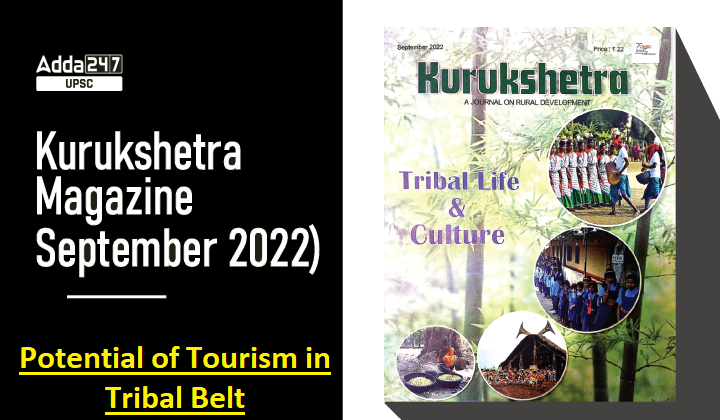Table of Contents
Kurukshetra is a Monthly Magazine which is issued by the Publications Division of the GOI.
Kurukshetra Magazine is one of the most important and indispensable source for UPSC Civil Services Exam Preparation. Keeping this in mind, here, we come with ”Analysis Of Kurukshetra Magazine” on daily basis, which covers the monthly Kurukshetra Magazine in easy and smooth pointed form, keeping in mind the demand of UPSC aspirants.
Potential of Tourism in Tribal Belt: Introduction
- The ecological setting in which Scheduled Tribes live, along with their unique cultural attributes are facets that can be a tourism offering.
- However, monitoring the negative socio-cultural impacts of such forms of tourism and regulating tourism development plans accordingly is very important.
Potential of Tourism in Tribal Belt: What is Tribal Tourism?
- Tribal tourism refers to a form of travel in which tribes allow tourists to experience authentic indigenous life (tribal habitat, heritage, history and handicrafts, culture, values and traditions) by allowing the tourists to visit their villages for them to be exposed to a culture completely different from their own.
- The intangible heritage that the tribal population possesses including the traditional knowledge system contains many positive and productive elements that are really precious for the entire humanity.
- Tourism can be a tool through which the rich cultural heritage of the tribes such as folklore, costume, jewellery and lifestyle, their sustainable ways of living, indigenous practices by tribal healers and medicinal plants can be offered as a unique attraction to the potential visitors.
Potential of Tourism in Tribal Belt: What is Eco-Tourism?
- Ecotourism is responsible travel to natural areas that conserves the environment and improves the well-being of local people.
- With the growing city culture, civilized man is slowly moving away from the natural environment and therefore there is an increasing demand for ecotourism’ all over the world.
- The main objective of eco-tourism is to preserve the natural environment and to promote local employment.
- When preservation is combined successfully with development-the preserve and use mandate-sustainable development is achieved.
- Keeping this in view, there has been a rapid growth of eco-tourism activities in tribal pockets of India
- Efforts are being taken to use eco-tourism potential for keeping the tribals in promoting their eco-friendly economic pursuits.
- Recently, the GOI has also launched the National Strategy for Eco-Tourism 2022.
Tribal Tourism and Museum Development in Uttar Pradesh: A Case Study
- The Tharu Tribes live in fertile Terai (foothills of the Himalayas) lowlands in Uttar Pradesh and majority of the Tharu people work either as forest dwellers or are farmers.
- This tribal group also has a presence in Nepal, Bihar and Uttarakhand.
- Tharu people worship mainly their tribal Goddess (Earth) which they refer to as ‘Bhumsen’ in their language. They are also worshippers of Theravada Buddhism.
- Tharu people plant rice, wheat, mustard, corn, and lentils. They also collect minor food products from forests like wild fruits, medicinal plants, etc. They hunt deer, rabbit and wild boar and also do fishing.
- Their homes are decorated and coloured, Wine made by rice is quite popular in this tribe.
- The Uttar Pradesh Government has started a new programme connecting Tharu villages with the ‘home stay scheme’ of the UP Forest Department with an objective to offer tourists an experience of living in the natural Tharu habitat that contains traditional huts made of materials naturally found in the forest.
- U.P government also announced ‘Tharu Janjati Museum’ to preserve and promote the cultural facets. There is a huge demand for tribal artefacts, textiles, ornaments, paintings, potteries, cane and bamboo products, and organic and natural food products.
Potential of Tourism in Tribal Belt: Ecotourism guidelines in and around protected areas 2021
- In order to regulate and encourage planned development of areas in and around protected areas, the Ministry of Forest, Environment and Climate Change notified “Ecotourism guidelines in and around protected areas 2021”.
- These guidelines are based on the key recommendations of the Tiger Task Force (2005), provisions contained in Wildlife (Protection) Act 1972, Schedule Tribes and Other Forest Dwellers (Recognition of Forest Rights) Act 2006.
Potential of Tourism in Tribal Belt: Way Forward
- Tourism may act as a monetary incentive for cultural preservation and promotion, and can prevent cultural facets from fading into oblivion.
- These concepts are a part of the wider umbrella of Alternative Tourism which in essence means tourism activities or development that are viewed as non–traditional.
- The most fundamental premise of ensuring success of using tourism as a means to preserve and promote tribal heritage is to consider the opinion of tribal communities and their participation in planning and development of tribal tourism at each and every stage of tourism development.
- Local people should be encouraged to undertake leadership roles in planning and development with the assistance of government and business enterprises.



 TSPSC Group 1 Question Paper 2024, Downl...
TSPSC Group 1 Question Paper 2024, Downl...
 TSPSC Group 1 Answer key 2024 Out, Downl...
TSPSC Group 1 Answer key 2024 Out, Downl...
 UPSC Prelims 2024 Question Paper, Downlo...
UPSC Prelims 2024 Question Paper, Downlo...





